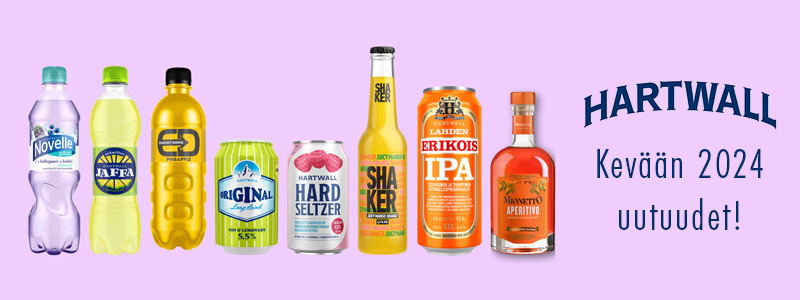Wooden Pickle Brewing: Põhjala Pime Öö clone attempt
I’m using the term clone loosely here. In no way am I expecting the beer to come out exactly as Põhjala’s Pime Öö. That would be insane. Kind of like expecting a re-make of Top Gun with me playing the role of Maverick to come out exactly as the original, just because I got the same script that Tom Cruise got.
Let’s compare,
- Acting skills: Never tried acting myself so odds are Tom has the edge.
- Charisma, looks & youth: Next category please.
- Fist pumping while riding a bike alongside a fighter jet: I have longer hair, which would be a nice effect when riding at high speeds, but only if I wouldn’t be too afraid to ride without a helmet, or too afraid of letting go of the handlebar long enough to fist pump in the first place, so Tom again.
- Beach volleyball skills: Here I would give myself the nod. Not that I’ve played much volleyball, but I’m taller. My main weakness is having to play shirtless, which I suppose one would have to in a movie like this, so volleyball is a draw when you factor in the amount of oil it would take for me to look good without a shirt.
- Finally, singing You’ve lost that lovin’ feelin’ at a bar to impress women: Tom isn’t much of a singer, but neither am I. The only song you’ll ever catch me singing in public is David Hasselhoff’s Looking for freedom, which lyrically wouldn’t make any sense in that scene.
Basically what I’m trying to say is, if the brewers at Põhjala are in any way comparable to the cast of Top Gun, which I have no reason to doubt, I have a tough challenge ahead of me.
Pime Öö— PX
I’ve always paid much more attention to brewing processes than recipes. As long as the recipe is in the right ballpark you should be good if you know how to brew. There is something special about Põhjala’s imperial porters and stouts though. They are incredibly rich and full, but always smooth, the exact opposite of my stouts. I still believe that what sets Põhjala’s dark beers apart from other stouts or porters come from their processes, their water profile, barrel aging, etc., not so much their recipes. But just to eliminate any room for speculation, I decided to try to get my hands on the recipe for Pime Öö PX, the beer that introduced me to Põhjala’s cellar series.
Googling gave no results, so next I headed to Põhjala’s web site to see what information I could find there. Some breweries list the ingredients of their beers on their web sites. And apparently so does Põhjala.
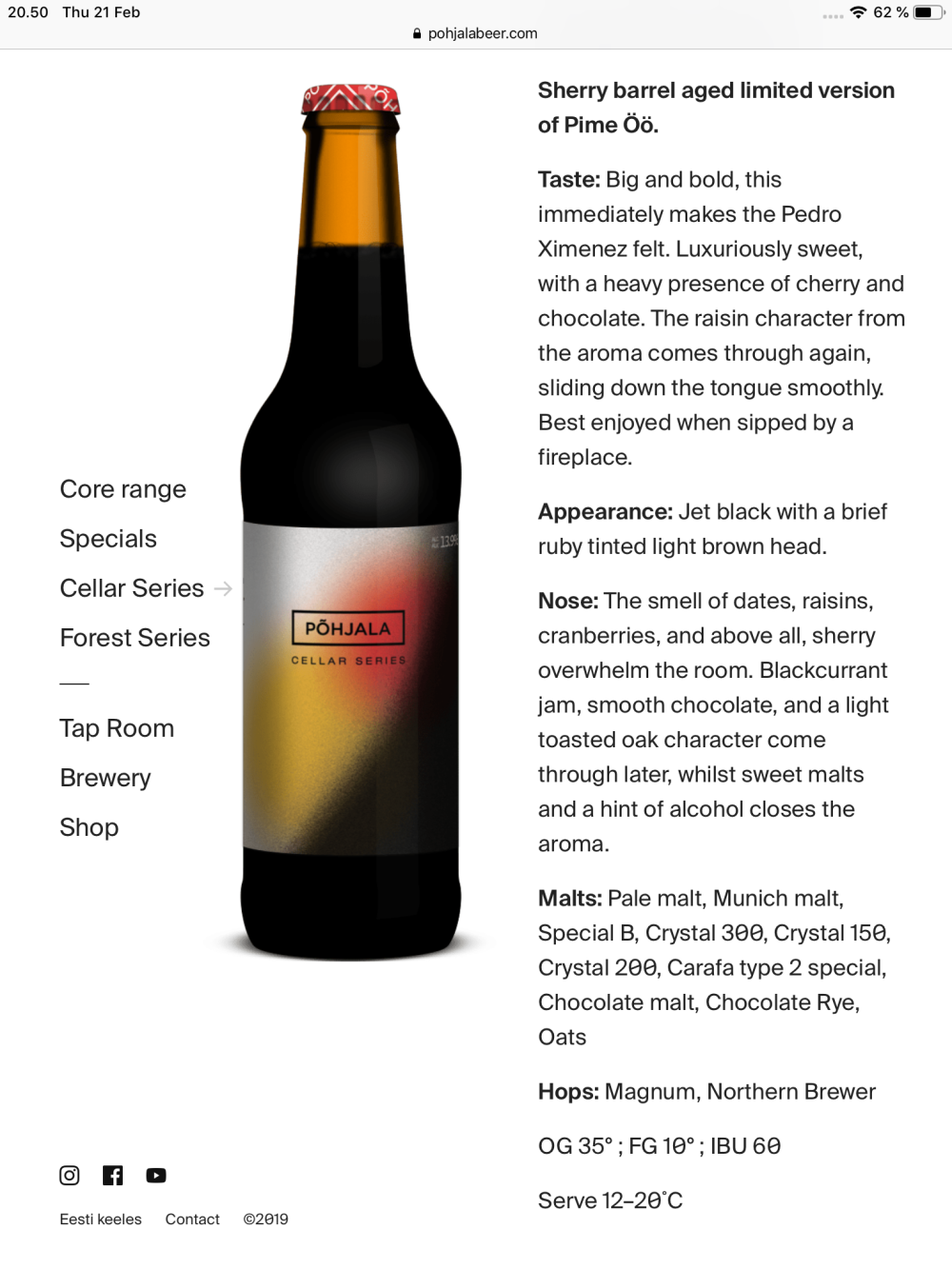
This is already some great information. I know Põhjala uses mostly Viking malts, but the Carafa and the chocolate rye you need to get from Weyermann, and the Special B from Dingemans. Carafa is a dehusked malt, and rye is naturally huskless, so maybe using these malts instead of the normal roasted barley and black malts attributes to the smoothness. The astringent flavors associated with roasted grains usually come from the husks.
I don’t recall Pime Öö having much hop character so I would use the hops mainly to get the 60 IBU’s, and probably only use Magnum at 60 minutes for simplicity. OG should be 1.154 and FG 1.040. Not sure what yeast strain Põhjala uses, but I would use either WLP001 or WLP007. 001 has a higher alcohol tolerance which might come in handy, but I happened to have 007 on hand, so I used that one.
Based on the information above I made this recipe:
- 7.5 kg Viking pale ale malt
- 1.5 kg Viking dark Munich malt
- 0.5 kg Viking crystal 150
- 0.5 kg Viking crystal 300
- 0.5 kg Dingemans Special B
- 0.5 kg Viking dark chocolate malt
- 0.5 kg Weyermann chocolate rye
- 1 kg Weyermann Carafa type 2
- 0.7 kg Pirkka Oats
- 60 IBU’s of Magnum at 60 minutes
- WLP007
I never got to brew this recipe though. Before I got the chance, I sent Põhjala an e-mail asking for the recipe, and their head brewer was kind enough to share it, which really elevated Põhjala to first spot on my list of favorite breweries (I don’t actually carry around a list). I didn’t ask permission to post the recipe online though, so I’m not going to. Sorry! But you know what? I honestly think you could make just as good of a stout with the recipe above as with the actual recipe. It’s that close! So close I’m actually having a hard time not sharing it just for bragging rights.
As you can see I skipped the crystal 200, I didn’t see the purpose of having four different crystal malts. This much I will tell you, in the current recipe Põhjala has also skipped the crystal 200, as well as the crystal 150. Also, they have now started to add Muscovado sugar as well. Recipes evolve, and the recipe above is a good place to start.
-
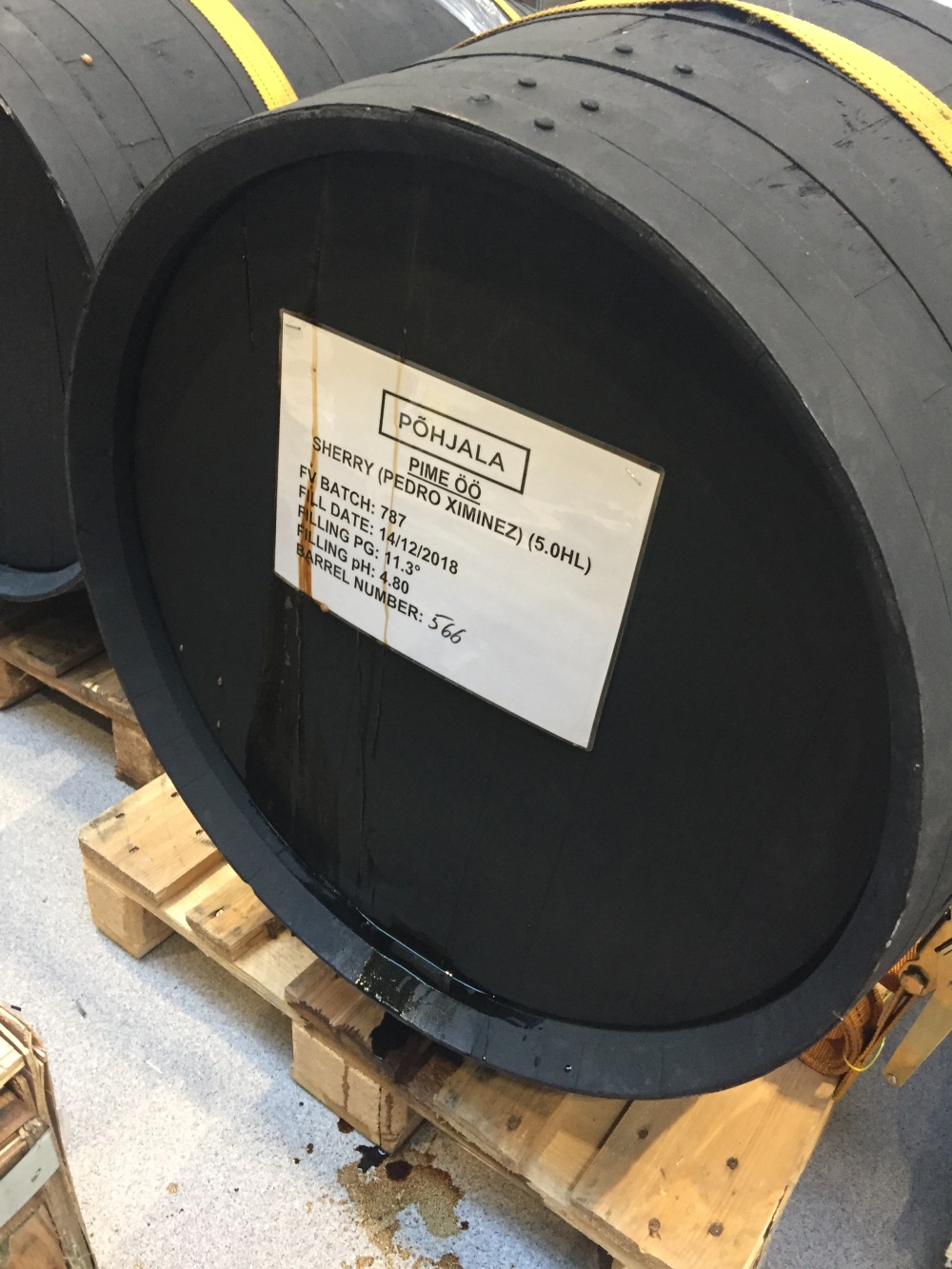
Pime Öö PX barrel aging at Põhjala’s brewery. Both the filling gravity and the PH are surprisingly high. 11.3 Plato equals 1.045 in specific gravity and a PH of 4.8 is about as high a PH you’ll ever see in a beer post primary fermentation.
Brew day
The brew day did not go without hiccups.
- I overshot the mash temp by almost 5 degrees. I have no idea why. Usually I’m spot on. The only difference this time was that instead of the usual 3/1 water to grist ratio, I mashed really thick, with a ratio of 1.9/1. I got the temperature down quite quickly by adding cold water though.
- I once again got a stuck lauter. I’ve always thought that this would be an issue when using high percentages of huskless grains, but to me it has only happened twice, when brewing imperial stouts, i.e. when using shitloads of grains.
- Evaporation rate was lower than expected, which resulted in 23 liters of wort at the end of the boil instead of 20 liters as planned. Normally I would have kept on boiling, but I had plans that evening and ran out of time. Target OG was 1.130, but ended up at only 1.113. If you remember, Pime Öö has an OG of around 1.154, but I decided not to aim that high on my first attempt because I didn’t want to risk getting a stuck fermentation. I suppose this will be a session Öö. A sessiÖön if you will.
Otherwise things went fine. I mashed for 90 minutes, during which the temperature dropped from 67 —°C to 63 —°C. That’s another thing I’ve been wondering about. Is there a drawback to losing a few degrees during the mash, if you start a little higher than you otherwise would? Usually I turn on the heat every 20-30 minutes to keep a steadier temperature, but this time I decided to just let the mash sit and watch some TV. Mash PH was 5.27, and sparge PH 5.45. The only water adjustment I did was adding 2 tsp of chalk to the mash.
I boiled for 2.5 hours, cooled the wort down to 18 —°C before pitching yeast. As with my previous brew, I plugged my aquarium pump into a timer and set it to pump air 12×15 minutes, with one hour between sets. After that 15-hour aeration period fermentation had not yet started, but when I got home from work 9 hours later, fermentation was already at full speed.
-
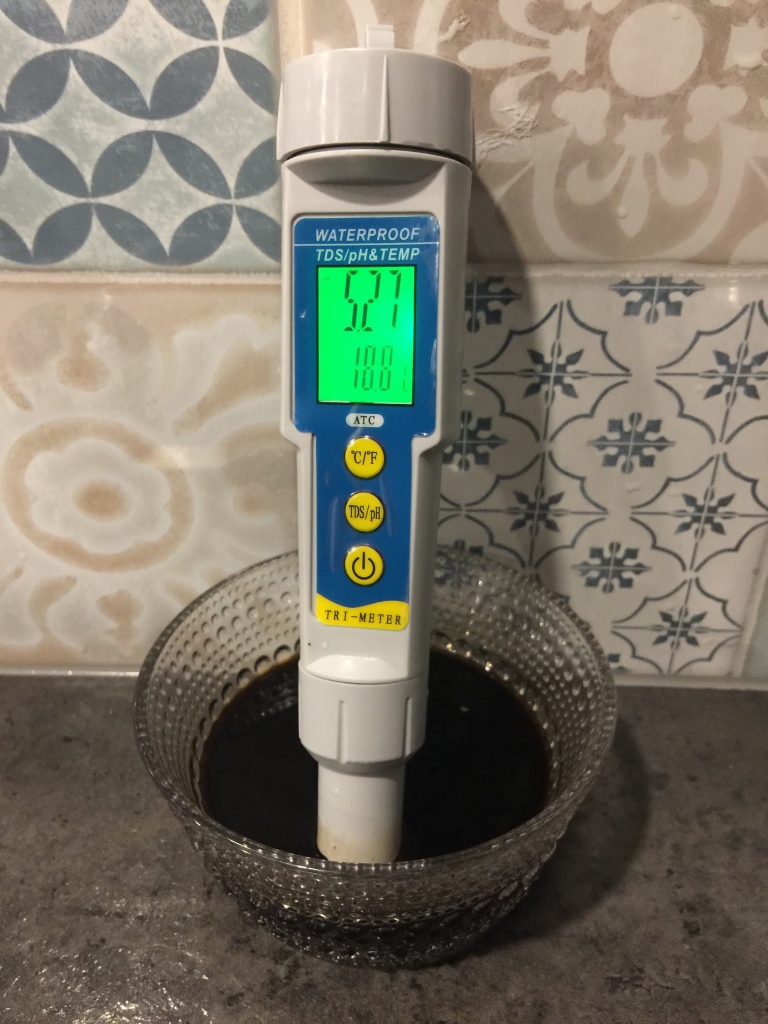
Mash PH was 5.27. -
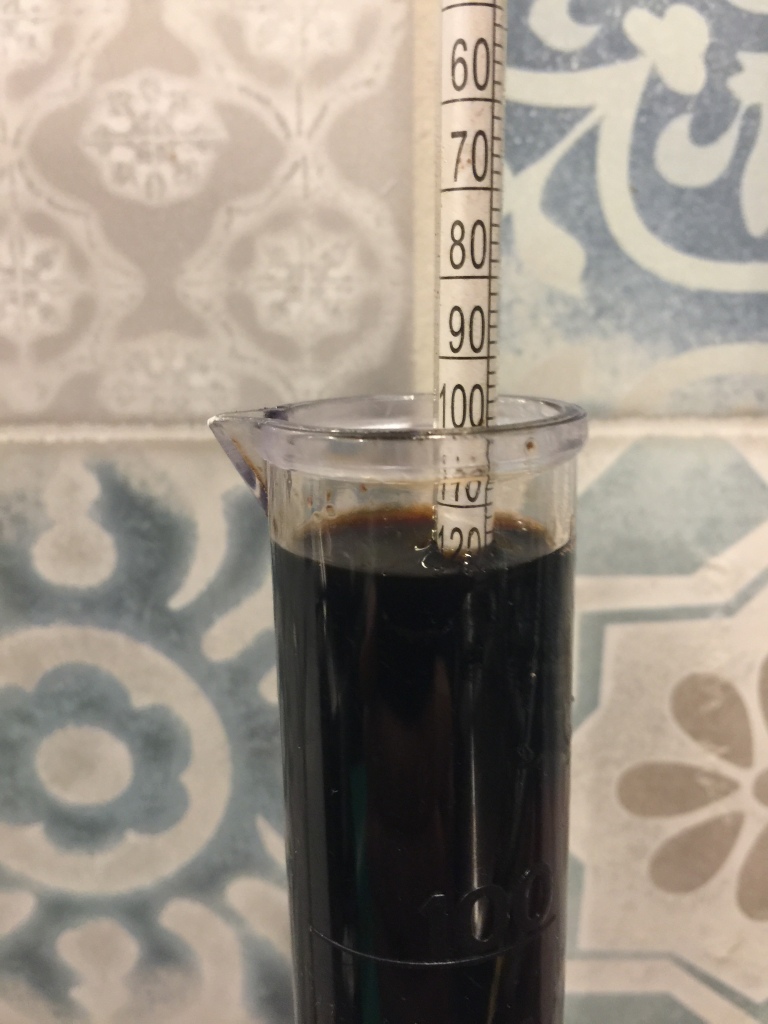
OG was 1.113 instead of the targeted 1.130. Efficiency was as anticipated (70%), but a lower than expected evaporation rate during the 2.5-hour boil meant a more diluted beer.
Fermentation
Despite the relatively high OG, fermentation was more or less done within five days. FG ended up at 1.030, which gives an ABV of around 11%. Attenuation level was as expected, 74%. I kept fermentation at 18—°C for the first three days after which I let it slowly rise towards 19—°C. Once fermentation was done I kept the beer at room temperature for an additional eight days before moving the beer to the keezer. PH of the fermented beer was 4.50, i.e. 0.3 below that of Pime Öö, but still in the normal range. According to Brewdog’s DIY dog, most if their stouts have a final PH of 4.4, so PH should not be too much of an issue.
My plan is to first “lager” the beer a few months in a keg (with a cut off dip tube) at about 2 —°C, then transfer the beer to another keg and add oak cubes. l’ll probably soak the oak cubes in some sort of liquor before adding them. Haven’t decided what kind yet. My original plan was soaking them in Pedro Ximenes sherry, but since the specs came out quite different than those of Pime Öö PX I might leave that for next time and go with bourbon or rum instead. Maybe I’ll even split the batch and try both, who knows. Can’t wait to see how this one will turn out!


